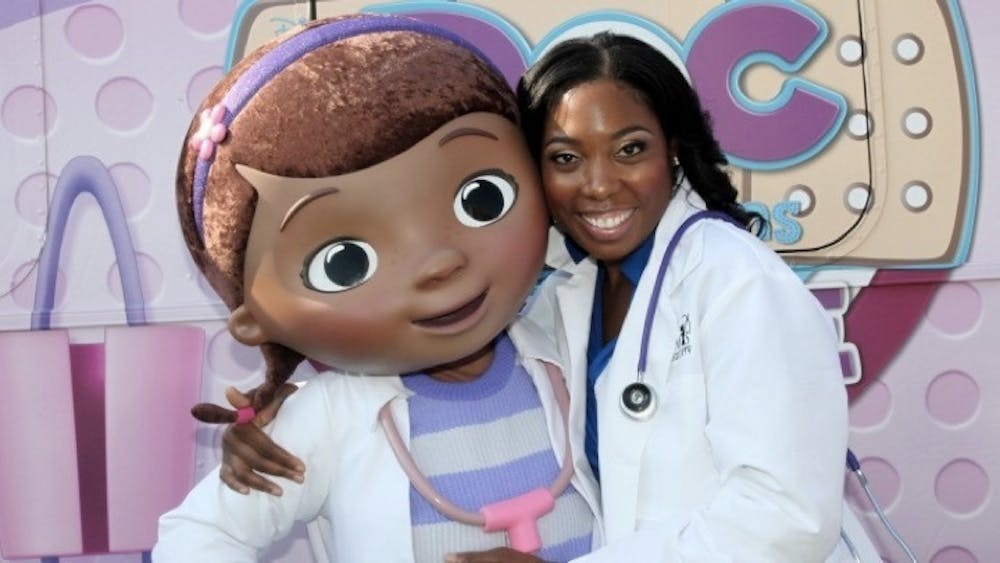The doc is in! For Myiesha Taylor, a board-certified emergency medicine physician specialist, the doc is always in. On Tuesday, Feb. 21, at 5:30 p.m., Taylor will present via Zoom a lecture titled “How a Cartoon is Changing the Face of Medicine.” The lecture is part of Ohio University’s Black History Month events.
In her keynote, Taylor will discuss the power of representation in film and media, specifically looking at the 2012 animated television show, “Doc McStuffins.” Ending in 2020, the Disney Junior show was centered around a six-year-old girl caring for her stuffed animals’ various ailments.
While it may seem like a rather simple concept, the TV show focused on educating kids on how to take care of their bodies and be healthy. Additionally, "Doc McStuffins” encourages kindness, respect and tolerance. The show preaches the message that brains and heart are just as valuable as beauty.
Besides being a doctor herself, Taylor has a special connection with the animated show. She is a founding member of Artemis Medical Society, an organization designed to champion women physicians of color. Some of their programs consist of raising awareness of preventive medicine and healthcare in minority communities as well as internationally.
Due to her work with Artemis, Disney Junior honored Taylor by naming Doc McStuffins’s mother “Myiesha,” after Taylor herself.
“When I did that, and I dived into this work, Disney recognized it and then they incorporated parts of what I had to offer into what they were doing,” Taylor said. “As a nod, the mother character of ‘Doc McStuffins’ is named after me.”
Taylor said the company suggested Doc herself, but she was against it, feeling like the mom was the better choice since she was the trained pediatrician Doc often consulted.
“I said her mom should be me because the kid is cute, but the kid hasn’t gone to medical school,” she said, laughing.
Taylor said the creation of the show is monumental because it serves not only as an educational platform for health but also as a vehicle for representation of different identities.
“What we want to see is we want to see images and reflections of ourselves in popular culture,” she said. “Everybody does because it shows the culture, it shows society that you are a part of it. All of these people represent America.”
She said what also makes the show special is the fact Doc’s identity is not the focus of the show. Other children shows in the past that have featured minorities, such as “Dora the Explorer” or “Ni Hao, Kai-Lan,” use the main character’s identity as a key component of the show. While there is nothing wrong with this, Taylor believes it’s refreshing to see a minority lead character where identity is merely a detail of the character.
“When you look at the story, they could literally cut and paste any child and not even change the script at all, and it still fits,” Taylor said. “So for me, that was fantastic. Then, of course, the content is good. It teaches kids the basics about health.”
Taylor talked about the different preconceptions she has had to navigate as a Black female physician, saying people sometimes automatically assume she is not the doctor among the other healthcare workers. Not only is this frustrating for Taylor to deal with, it also wastes valuable time she can be treating patients in the emergency room.
“(You’re) a Black woman doctor, but when you walk into the hospital, you walk into the emergency department, nobody sees you as the doctor,” she said. “Now, instead of just entering at a level of mutual understanding among the healthcare team, … I have to convince every member of the team every time I interact with them, that yes, I’m the doctor. How long does it take before that trust is developed where we can, as a team, provide good care to our patient.”
Taylor said this confusion often leads to a lack of communication when it comes to setting up supplies and attending to patients. She said that this can all be avoided if people put their prejudices aside and stick to their roles.
“If they assume that I’m the doctor, and we can get past that, then everybody gets better care because it’s faster,” Taylor said. “The team works better together.”
In her lecture, Taylor plans to touch on a variety of topics, including demographic changes in not only the U.S. but all around the world. With the population of people of color rapidly growing, where racial groups who are now considered a minority will eventually become the majority. She talked about the importance of educating oneself and in their prejudices and misconceptions because the world is rapidly growing and changing.
“As a white man, if you (have to) understand the value of diversity and embrace it and learn how to talk to groups of people and learn how to fit in and work a team and understand your role as a team player, and (you’re) not necessarily appointed team leader status just because you have a white penis, and that you have to earn it like everybody else,” Taylor said. “If you can understand that, then you can function in this world where you won’t necessarily be the boss.”
The event is co-hosted by OU’s Division of Diversity and Inclusion as well as departments from the Heritage College of Osteopathic Medicine Departments. All parties interested in attending the lecture can register by filling out this survey.
Whether one is a patient in the emergency room or at McStuffinsville Toy Hospital, Taylor and Doc are in agreement that everyone needs a doctor sometimes.






